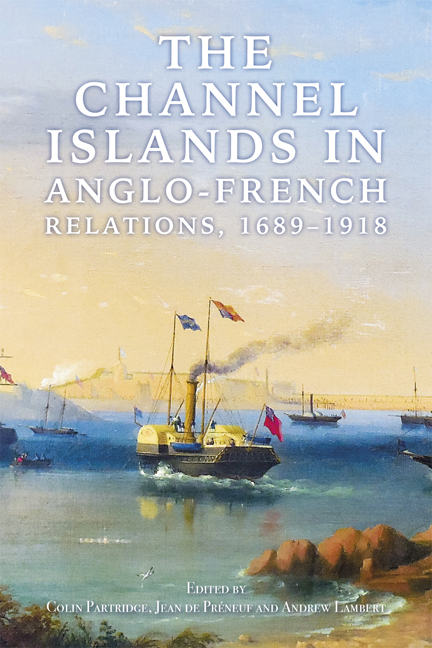Book contents
- Frontmatter
- Dedication
- Contents
- List of Illustrations
- List of Contributors
- Preface
- Introduction: ‘The Ehrenbreitstein of the English Channel’
- Part 1 Corsairs – the Ancien Régime and French Wars from 1689
- Part 2 The Islands – French and British Intelligence from the Seven Years War to 1815
- Part 3 Territorial Waters – the Land and Sea Interface from the 17th to 20th Centuries
- Part 4 Engineering Strategic Change
- Part 5 Alderney and the Channel Islands – Naval Strategy from 1815 to 1905
- Part 6 Civil Societies and Anglo-French Naval Rivalry – the 19th Century to WWI
- Part 7 Trade War – the Protection of Channel Islands Shipping in the Great War
- Afterword: Alderney, The Channel Islands, and the Study of History
- Bibliography
- Index
11 - The Channel Islands in French Naval Strategy During the First World War
Published online by Cambridge University Press: 15 May 2024
- Frontmatter
- Dedication
- Contents
- List of Illustrations
- List of Contributors
- Preface
- Introduction: ‘The Ehrenbreitstein of the English Channel’
- Part 1 Corsairs – the Ancien Régime and French Wars from 1689
- Part 2 The Islands – French and British Intelligence from the Seven Years War to 1815
- Part 3 Territorial Waters – the Land and Sea Interface from the 17th to 20th Centuries
- Part 4 Engineering Strategic Change
- Part 5 Alderney and the Channel Islands – Naval Strategy from 1815 to 1905
- Part 6 Civil Societies and Anglo-French Naval Rivalry – the 19th Century to WWI
- Part 7 Trade War – the Protection of Channel Islands Shipping in the Great War
- Afterword: Alderney, The Channel Islands, and the Study of History
- Bibliography
- Index
Summary
Thirty kilometres off the Cotentin Peninsula, the Channel Islands are the closest British territory to the French coast. Because of this, and as also indicated by their compound French name − Les Îles Anglo-Normandes − they are an integral part of the history of the Channel as a ‘mer pour deux royaumes’ − a ‘sea shared by two kingdoms’ − the term coined by Renaud Morieux to describe this stretch of sea, now a border between France and Great Britain. For André Lespagnol, they ‘have been heavily involved for centuries in the everyday life of this part of the French Atlantic seaboard’. They have also long been a source of concern for the French navy. Island strongholds, they represent a threat to Cherbourg, the town whose dockyards were nevertheless chosen for the construction of a fleet intended to rival that of the Royal Navy.
But in the early years of the twentieth century, the Channel Islands’ geostrategic worth decreased significantly. For the British, worried by German sea power, the islands were losing their importance in favour of bases in the North Sea. For the French, the Entente Cordiale seemed to remove the danger of an attack from Britain. So, for both countries the Channel was a sea at peace in 1914. Should conflict break out and an alliance be formed between the two countries, it would even be a central part of their shared military strategy. Events proved them right, as the Channel quickly became both a hunting ground for German submarines and a lifeline for the Franco-British war effort. A closer look at the French navy, and at the Channel Islands during the First World War, can shed new light on relations between the two navies, specifically in respect of the protection of sea routes.
Since the in-depth studies of the 1920s, little research has been carried out into the role of the French navy during the First World War, particularly in the Channel, which has long been considered a secondary theatre of operations. That early work was very much of its time: mostly designed and undertaken by military institutions, navy-centred, nationalist in outlook, mostly in written form, and largely positivist and utilitarian in style. However, the centenary of the First World War has sparked renewed interest.
- Type
- Chapter
- Information
- The Channel Islands in Anglo-French Relations, 1689-1918 , pp. 217 - 233Publisher: Boydell & BrewerPrint publication year: 2024



